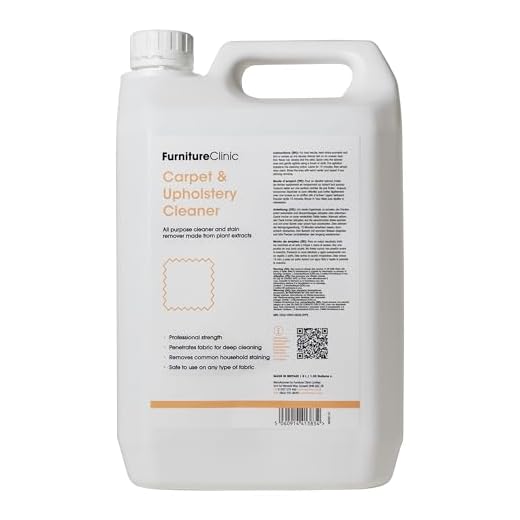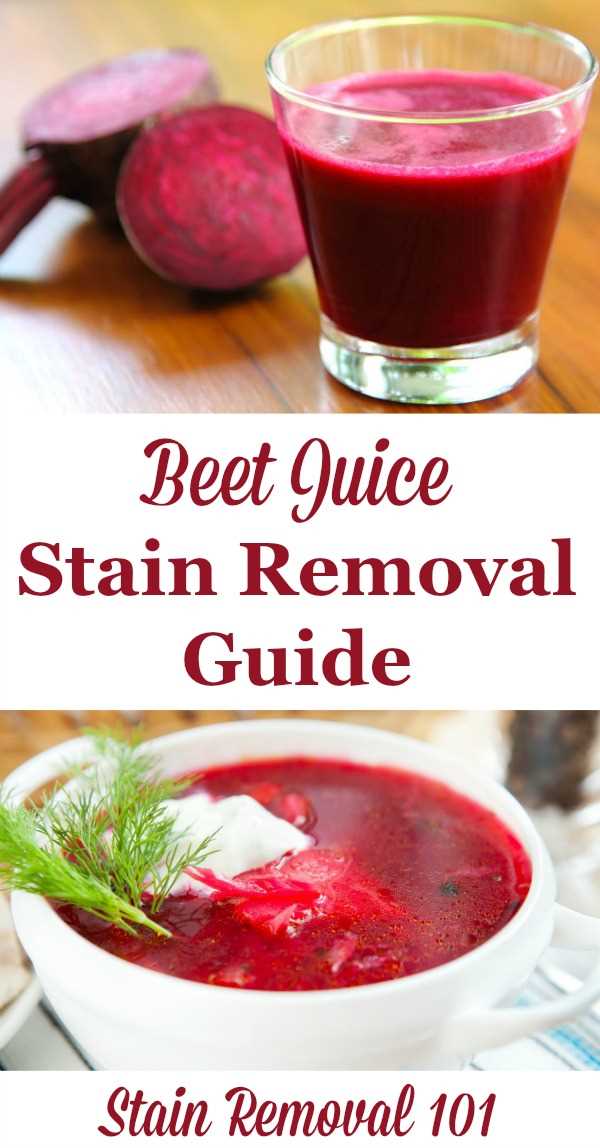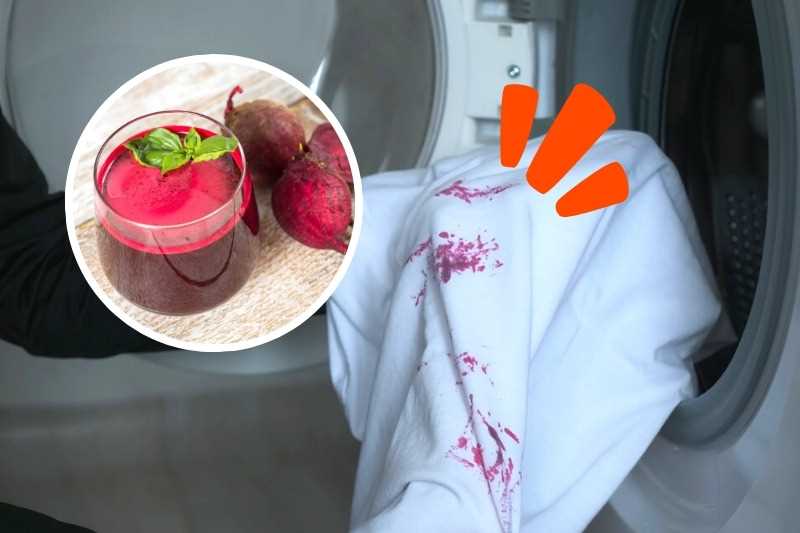




Beetroot is known for its vibrant color and delicious taste, but it can also leave stubborn stains on various surfaces. Whether it’s on clothing, carpets, or kitchen utensils, beetroot stains can be quite difficult to remove. However, with the right techniques and some patience, you can successfully get rid of these stubborn stains and restore your items to their original condition.
Prevention is always better than cure. If you’re planning to use beetroot in your cooking or any other activity that may lead to stains, it’s best to take some preventive measures. Wearing an apron or old clothes can save your favorite garments from potential staining. Additionally, placing a newspaper or a plastic cover on your work surface can help catch any beetroot juice spills and prevent them from seeping into the material.
When it comes to removing beetroot stains, time is of the essence. As soon as you notice a stain, it’s important to act quickly. The longer the stain sets in, the more difficult it will be to remove. Start by gently blotting the stain with a clean cloth or paper towel to absorb any excess moisture. Avoid rubbing the stain, as this can push it deeper into the fabric or surface.
There are several effective techniques you can try to remove beetroot stains.
For clothing, soaking the stained area in cold water with a small amount of laundry detergent can help loosen the stain. After soaking for about 30 minutes, gently rub the stain with a soft brush and then rinse with cold water. Repeat this process until the stain disappears completely. For stubborn stains on surfaces like countertops or cutting boards, mixing baking soda with water to create a paste and applying it to the stain can help break it down. Let the paste sit for a few minutes before scrubbing it off with a sponge or cloth. Additionally, using a stain remover specifically designed for vegetable-based stains can also be effective.
Understanding Beetroot Stains
Beetroot, a vibrant and nutritious vegetable, is notorious for leaving stubborn stains on clothing, surfaces, and kitchen utensils. The deep red pigment found in beetroot, called betalain, has strong staining properties that make it difficult to remove.
Beetroot stains are often a cause for frustration, as they can ruin your favorite clothes or stain your kitchen countertops. Understanding the nature of beetroot stains and using the right techniques can help you effectively remove them.
Why are beetroot stains difficult to remove?

The strong staining power of beetroot lies in its natural pigment, betalain. Betalain is a water-soluble compound that easily penetrates porous surfaces such as fabric, wood, or stone. Once betalain comes into contact with these surfaces, it quickly binds to their fibers or pores, resulting in a stubborn stain.
Additionally, the deep red color of beetroot stains can also be intensified by heat or exposure to sunlight, further complicating the stain removal process.
Preventing beetroot stains
While it’s impossible to completely prevent beetroot stains, there are steps you can take to minimize their occurrence:
- Wear an apron or protective clothing when handling and preparing beetroot to avoid direct contact with your clothes.
- Cover surfaces and utensils with plastic wrap or parchment paper to create a barrier between the beetroot and the surface.
- Handle beetroot with care and avoid dropping or spilling it on surfaces to prevent immediate stains.
Effective stain removal techniques
When faced with a beetroot stain, it’s essential to act quickly to increase the chances of successful removal. Here are some tried-and-tested techniques:
- Flush the stain with cold water:
- Apply a stain remover:
- Pre-treat with vinegar:
- Wash with detergent:
- Check for traces:
Start by rinsing the stained area under cold running water to dilute and flush out the pigment. Avoid using hot water, as it can set the stain.
After rinsing, apply a stain remover directly onto the stain. Allow it to sit for a few minutes to break down the pigment. Follow the instructions on the stain remover product for the best results.
If the stain persists, try pre-treating it with white vinegar. Soak a cloth or sponge in vinegar and gently dab the stained area. Vinegar helps break down the pigment and can aid in stain removal.
Once you’ve treated the stain, wash the garment or surface with a suitable detergent according to the fabric or material’s care instructions. Use the highest appropriate temperature for the best chance of removing the stain.
After washing, check for any traces of the beetroot stain. If it’s still visible, repeat the stain removal process or consider seeking professional help.
By understanding the nature of beetroot stains and using effective stain removal techniques, you can tackle even the most stubborn beetroot stains with confidence.
The Importance of Quick Action

When it comes to removing stubborn beetroot stains, acting quickly is key. The longer you wait, the more difficult the stain becomes to remove. Beetroot contains natural pigments that can leave behind deep, vibrant stains on various surfaces, including fabric, countertops, and dishes.
Prevent Permanent Stains
By taking quick action, you can minimize the chance of the stain becoming permanent. Beetroot stains have a higher chance of setting in if they are allowed to dry or if heat is applied to them. It is important to address the stain as soon as possible to prevent it from becoming a long-term problem.
Preserve the Quality of Fabrics and Surfaces
Acting quickly also helps to preserve the quality of fabrics and surfaces. Beetroot stains can penetrate deep into the fibers of fabrics and cause discoloration or damage. If not treated promptly, the stain may become more difficult to remove, leading to potential fabric or surface deterioration.
Reduce Cleaning Efforts and Costs
By addressing the beetroot stain promptly, you can save yourself time, effort, and potential costs. The longer the stain sits, the more challenging it becomes to remove. Quick action allows for easier stain removal methods, reducing the need for stronger cleaning agents or professional help.
Prevent Spread of the Stain
Acting quickly also helps prevent the spread of the stain to other areas. Beetroot stains can easily transfer to nearby fabrics or surfaces when left untreated. By promptly treating the stain, you can contain it and minimize the risk of further damage or staining.
Conclusion
Taking quick action when dealing with stubborn beetroot stains is crucial. Not only does it help prevent permanent stains and preserve the quality of fabrics and surfaces, but it also reduces cleaning efforts and costs. Act promptly to minimize the spread of the stain and increase the likelihood of successful removal.
Natural Solutions for Beetroot Stain Removal
Removing beetroot stains can be a challenging task, especially when they are stubborn and deeply ingrained. However, there are several natural solutions that can help effectively remove beetroot stains from various surfaces.
1. White Vinegar
White vinegar is known for its stain removing properties. To remove beetroot stains, mix equal parts of white vinegar and water and apply the solution to the stained area. Let it sit for a few minutes, then scrub gently with a cloth or sponge. Rinse with water and repeat if necessary.
2. Lemon Juice
Lemon juice is another effective natural solution for removing beetroot stains. Squeeze fresh lemon juice onto the stain and let it sit for a few minutes. Gently scrub the area with a cloth or sponge, then rinse with water. Repeat the process if needed.
3. Baking Soda
Baking soda is a versatile cleaning agent that can also help in removing beetroot stains. Make a paste by mixing baking soda with water and apply it to the stain. Let it sit for a few minutes, then gently scrub the area with a cloth or sponge. Rinse with water and repeat if necessary.
4. Salt
Salt can also be used to remove beetroot stains. Sprinkle salt generously onto the stained area and let it sit for a few minutes. Scrub the area gently with a cloth or sponge, then rinse with water. Repeat the process if the stain persists.
5. Hydrogen Peroxide
Hydrogen peroxide is a powerful stain remover. To remove a beetroot stain, pour a small amount of hydrogen peroxide onto the stain. Let it sit for a few minutes, then gently scrub the area with a cloth or sponge. Rinse with water and repeat if needed.
6. Dish Soap

For fresh beetroot stains, dish soap can be an effective solution. Apply a few drops of dish soap onto the stain and gently scrub the area with a cloth or sponge. Rinse with water and repeat the process if necessary.
7. Cornstarch
Cornstarch can absorb beetroot stains and make them easier to remove. Sprinkle cornstarch onto the stained area and let it sit for a few minutes. Gently brush off the cornstarch, then rinse with water and repeat if needed.
8. Club Soda
Club soda can also help in removing beetroot stains. Pour a small amount of club soda onto the stain and let it sit for a few minutes. Gently blot the stain with a cloth or sponge, then rinse with water. Repeat the process if necessary.
Remember to always test these natural solutions on a small, inconspicuous area before applying them to the entire stained surface. Additionally, it’s important to treat beetroot stains as soon as possible to prevent them from setting in.
Household Cleaning Products for Beetroot Stain Removal
When faced with a stubborn beetroot stain, there are several household cleaning products that can help you effectively remove it. These products are often readily available in most homes and can save you from needing to purchase specialized stain removers.
1. Baking Soda
Baking soda is a versatile cleaning agent that can be used for numerous household cleaning tasks, including beetroot stain removal. To use baking soda, follow these steps:
- Wet the stained area with cold water.
- Apply a generous amount of baking soda directly onto the stain.
- Gently scrub the stain with a soft-bristled brush, working the baking soda into the fabric.
- Rinse the area with cold water and repeat the process if necessary.
2. Lemon Juice
Lemon juice is a natural stain remover that can effectively tackle beetroot stains. To use lemon juice, follow these steps:
- Cut a lemon in half and squeeze the juice directly onto the stain.
- Gently scrub the stain with a soft cloth or sponge, allowing the lemon juice to penetrate the fabric.
- Rinse the area with cold water and repeat the process if necessary.
3. White Vinegar
White vinegar is another common household item that can help remove beetroot stains. To use white vinegar, follow these steps:
- Mix equal parts white vinegar and water in a spray bottle.
- Spray the solution onto the stained area.
- Gently blot the stain with a clean cloth or sponge, working the vinegar solution into the fabric.
- Rinse the area with cold water and repeat the process if necessary.
4. Dish Soap
Dish soap is designed to remove tough stains from dishes, but it can also be effective in removing beetroot stains from fabrics. To use dish soap, follow these steps:
- Apply a small amount of dish soap directly onto the stain.
- Gently rub the soap into the fabric, working it up to a lather.
- Rinse the area with cold water and repeat the process if necessary.
It’s important to note that different fabrics may require different cleaning methods, so always spot test a small, inconspicuous area before applying any cleaning solution to the entire stain. Additionally, prompt action is key in successfully removing beetroot stains, so try to treat the stain as soon as possible.
Preventing Beetroot Stains in the Future
If you frequently cook or eat beetroot and want to avoid stubborn stains, there are several preventative measures you can take. By following these tips, you can keep your clothes, kitchen surfaces, and utensils stain-free.
1. Wear an Apron
When working with beetroot, it is best to wear an apron to protect your clothes. This will prevent any accidental spills or splatters from staining your favorite garments.
2. Use Gloves
Wearing gloves while handling beetroot can help prevent stains on your hands. Beetroot can leave a deep red pigment on your skin, which is difficult to remove. By wearing gloves, you can easily discard them after use and keep your hands clean.
3. Prepare a Clean Work Area
Before you start cooking with beetroot, make sure to clean your work area thoroughly. Wipe down countertops and other surfaces with a mild detergent to remove any existing stains or residue. This will prevent any staining from older beetroot spills.
4. Use Cutting Boards and Utensils with Dark Surfaces
When chopping or slicing beetroot, opt for cutting boards and utensils with dark surfaces. Dark surfaces are less likely to show stains, making it easier to clean up afterward.
5. Rinse Beetroot Immediately
If you accidentally spill beetroot juice on a surface or fabric, rinse it immediately with cold water. This will help dilute the pigment and make it easier to remove. Avoid using hot water, as this can set the stain.
6. Treat Stains Promptly
If you do end up with a beetroot stain, it is important to treat it as soon as possible. The longer the stain sets, the harder it will be to remove. Follow the steps in our guide on removing stubborn beetroot stains to effectively eliminate the stain.
7. Store Beetroot Properly
Properly storing beetroot can help prevent accidental spills and stains. Keep beetroot in a cool, dry place, away from other foods. Avoid storing it in plastic bags, as beetroot can release moisture and create a breeding ground for bacteria.
8. Be Cautious with Beetroot Juice
Beetroot juice can stain surfaces easily, so be cautious when using it in recipes. Place a protective cover on countertops, tables, or any other surfaces you will be working on to prevent staining. Clean up any spills immediately to avoid permanent stains.
By following these preventative measures, you can minimize the chances of beetroot stains and keep your kitchen clean and stain-free.
FAQ
How do I remove beetroot stains from clothing?
To remove beetroot stains from clothing, start by rinsing the stain with cold water to remove any excess beetroot juice. Then, apply a small amount of liquid detergent to the stain and gently rub it in. Let it sit for a few minutes before washing the garment as usual. If the stain does not come out completely, you can try using a stain remover or soaking the garment in a mixture of water and vinegar before washing.
What should I do if a beetroot stain has dried?
If a beetroot stain has dried, you can still try to remove it by following these steps. First, scrape off any excess beetroot material with a spoon or dull knife. Then, soak the stained area in cold water for about 30 minutes. After soaking, pretreat the stain with a stain remover or liquid detergent and gently rub it in. Let it sit for a few minutes before washing the garment as usual.
Can I use bleach to remove beetroot stains?
It is generally not recommended to use bleach to remove beetroot stains, especially on coloured clothing. Bleach can cause damage or discolouration to the fabric. Instead, try using alternative methods such as rinsing the stain with cold water, pretreating it with a stain remover or liquid detergent, or soaking the garment in a mixture of water and vinegar.
What if the beetroot stain is on a delicate fabric?
If the beetroot stain is on a delicate fabric, such as silk or wool, it is important to handle it with care to avoid damaging the fabric. Start by blotting the stain gently with a clean cloth or paper towel to remove any excess beetroot juice. Avoid rubbing the stain, as it may spread or make the stain worse. Then, follow the appropriate cleaning instructions for the specific fabric or consider taking it to a professional cleaner for assistance.
Are there any natural remedies for removing beetroot stains?
Yes, there are several natural remedies that can help remove beetroot stains. One method is to mix equal parts lemon juice and water, then apply the mixture to the stain and let it sit for a few minutes before washing the garment. Another option is to make a paste with baking soda and water, apply it to the stain, and let it sit for a while before rinsing. You can also try using white vinegar or hydrogen peroxide diluted with water as a pre-soak solution for stubborn stains.
What are some effective techniques for removing stubborn beetroot stains?
There are several effective techniques for removing stubborn beetroot stains. One technique is to soak the stained fabric in cold water for a few hours, then apply some liquid laundry detergent directly onto the stain and rub it gently. Another technique is to mix equal parts of white vinegar and water and apply the solution onto the stain, then blot it with a clean cloth. You can also try using a commercial stain remover or a paste made of baking soda and water to get rid of the stain.












